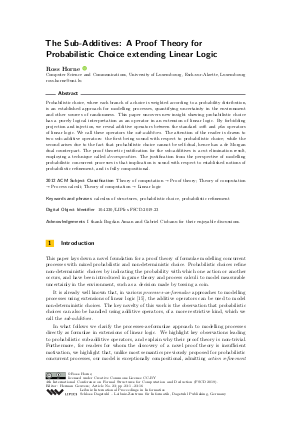@InProceedings{horne:LIPIcs.FSCD.2019.23,
author = {Horne, Ross},
title = {{The Sub-Additives: A Proof Theory for Probabilistic Choice extending Linear Logic}},
booktitle = {4th International Conference on Formal Structures for Computation and Deduction (FSCD 2019)},
pages = {23:1--23:16},
series = {Leibniz International Proceedings in Informatics (LIPIcs)},
ISBN = {978-3-95977-107-8},
ISSN = {1868-8969},
year = {2019},
volume = {131},
editor = {Geuvers, Herman},
publisher = {Schloss Dagstuhl -- Leibniz-Zentrum f{\"u}r Informatik},
address = {Dagstuhl, Germany},
URL = {https://drops.dagstuhl.de/entities/document/10.4230/LIPIcs.FSCD.2019.23},
URN = {urn:nbn:de:0030-drops-105300},
doi = {10.4230/LIPIcs.FSCD.2019.23},
annote = {Keywords: calculus of structures, probabilistic choice, probabilistic refinement}
}

 Creative Commons Attribution 3.0 Unported license
Creative Commons Attribution 3.0 Unported license

